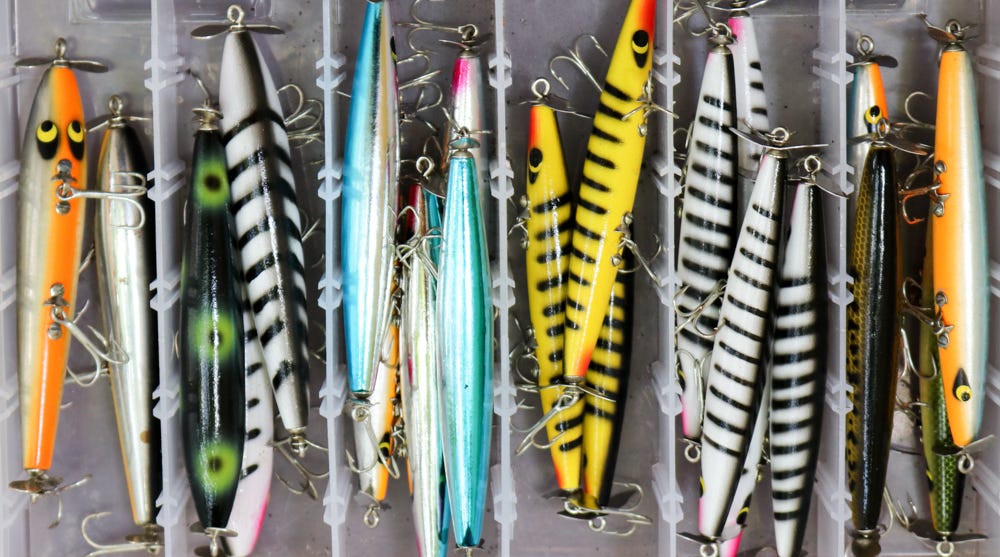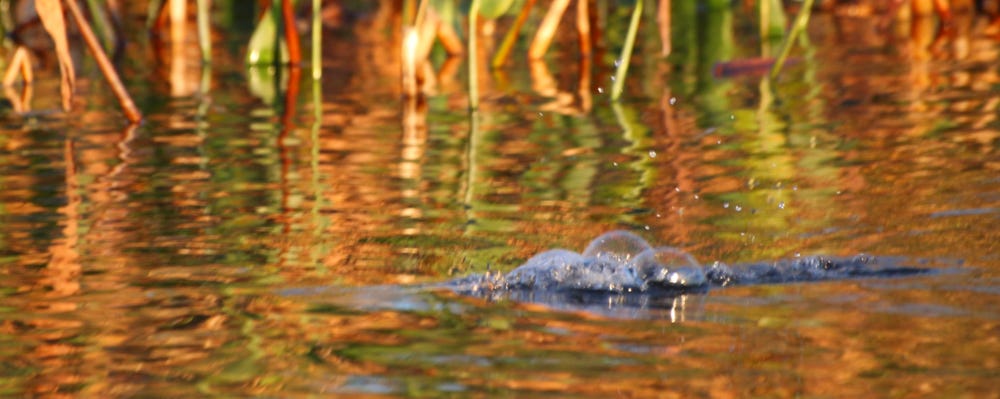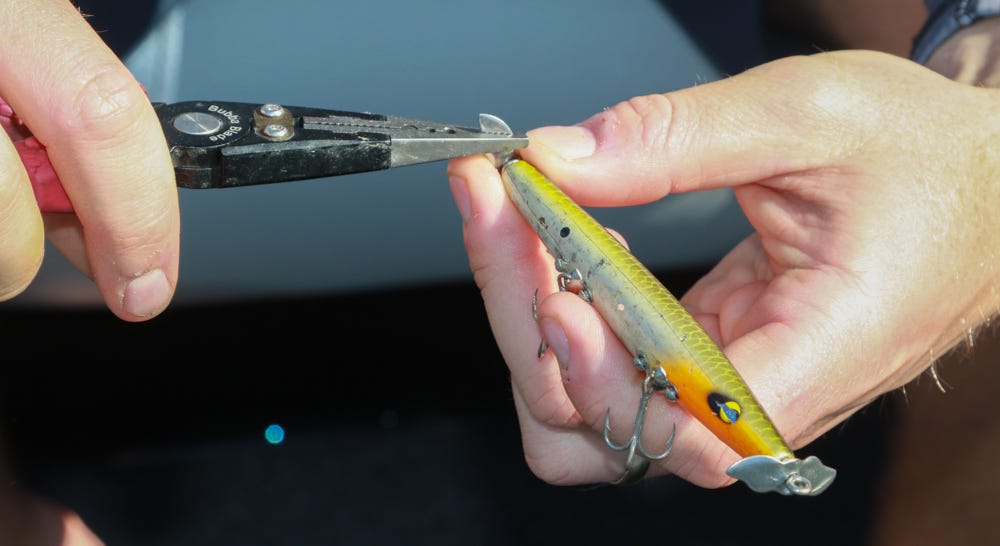- Feb 23, 2021
Topwater Fishing Tactics: How to Fish a Devil’s Horse for Bass
Learn why Bassmaster Elite Series pro Micah Frazier keeps a Devil’s Horse handy throughout spring and how he fishes this classic topwater lure.
If you think the Smithwick Devil’s Horse is a one-trick pony, listen to what Bassmaster Elite Series pro Micah Frazier has to say. In his view, this three-hook prop bait is a bona fide attention getter with broad bass fishing applications — particularly during the spawning season.
Effective at riling up big bass in all three stages of the spring ritual, the Devil’s Horse employs a bold, intrusive presence that quickly wears out its welcome. Far more flamboyant than a walking topwater, this bait’s drawing power and deal-closing potential is unquestionable.
Pre-spawn bass fishing approaches are pretty straightforward: Cover water and look for fish staging on docks, laydowns, rocky points, grass lines, etc. Once the spawn begins, the fish will move much shallower, and while sight fishing certainly plays a big role, it’s not the only game in town.
“In the springtime, this bait is one of the best ways to catch the big females without looking at them,” Frazier said. “A lot of times, if you can get that bait over a bed, or around a bed, a lot of times, the fish will bite it before you get up there and spook it. With a blade in the front and the back, it aggravates those big females into biting.”
Regarding locations, Frazier said, “When you’re in a spawning scenario, you want to throw that bait where you think there’s a high likelihood of there being a bed. If there’s a hole in the grass, a little protected pocket on the bank, or a laydown — just something where you think the odds are that there’s a bed.”
Vital Considerations


Water Clarity: “You may know they’re spawning, but you can’t see them,” Frazier said. “The water may be too dark. For example, a lot of times, the water in Florida is really black.”
Stick your rod tip into the water and you’ll notice that it’s not murk. Rather, it’s stained with tannic infusion from surrounding vegetation. Like dipping a spoon into a glass of ice tea, the utensil does not disappear, although the dark staining definitely lessens visibility.
Long Distance Relationships: Frazier carefully avoids encroaching on a bed fish’s comfort zone, as this will often send them packing. Even if a spooked fish holds its ground, skyrocketted wariness can kill the bass fishing game before it starts.
“If you can get a bait to those fish before they know you’re there, you’re a lot more likely to get them to bite. Once you spook them off the bed, it’s a lot harder to catch them.”
Frazier noted that this principle proves particularly relevant in tidal fisheries, because bedding bass realize their vulnerability when falling water decreases their concealment.
Time of Day: “When fish are spawning, after the sun gets up later in the day, it really pulls them up there and helps them lock onto those beds,” Frazier said. “That makes them more defensive, and that’s when they tend to strike that Devil’s Horse best, when they’re defending their beds.”
Post-Spawn


Once they’ve finished spawning, big females slide into deeper water, often pausing on some of the same spots they utilized for pre-spawn staging. Stressed-out post-spawners usually need a little R&R, but once they’re back in fighting form, they’ll be looking to regain the weight they lost during their reproductive effort.
The vulnerable appearance a Devil’s Horse presents often prompts an aggressive response. Frazier points to a couple more ideal prop bait scenarios that follow the bass spawn.
Fry Guarding: Looking just outside the spawning areas, Frazier targets the sparse grass where bass push their newly hatched young for protection. Laydowns offer similar fry protection, so adult bass will hold just outside nature’s equivalent to a crib and keep watch for any threat to the next generation.
A splashy Devil’s Horse would definitely qualify as a threat.
Bream Beds: Usually following not long after the bass spawn, this pattern presents bass with a favorite summer transition feeding opportunity. Often appearing in clusters known as honeycombs, bream beds typically occur in protected pockets. The panfish want sunshine on their nests, but bass will wolf pack the perimeters and rush in to gobble an unsuspecting meal.
“I’d target these specific areas, unlike the covering water strategy I’d use in the pre-spawn,” Frazier said. “
Techniques Pointers


Optimize your Devil’s Horse by minding these details.
Less is More: Frazier notes that, while the objectives vary by seasonal scenario, the presentations remain relatively consistent. Central to his strategy: Don’t overwork the Devil’s Horse. It’s not a buzzbait, so resist the urge to straight-line it.
“You make short twitches, and when you do that it throws water and males a bubbling noise on top of the water,” Frazier said. “That aggravates them. They don’t like it.”
Frazier said his Devil’s Horse retrieve is similar to how he’d work a popper. The difference with a prop bait is longer pauses.
“I picture the fish sitting down there looking at the bait, and when you twitch it one more time, it just drives them crazy,” he said. “A lot of times they eat it after it’s been sitting there still for a little while.”
A Twist of Fate: A Devil’s Horse works well right out of the package, but Frazier likes to tweak his baits for maximum appeal by twisting the blades. Not to be confused with bending blades inward or outward, Frazier makes this adjustment by firmly holding the bait, gripping one of the blade tips with piers and turning clockwise.
By imparting a slight swirl motion to each blade tip, he increases the speed at which it turns. This means maximum display during those short twitches.
Get to the Point: Another strategic modification involves hook replacement. Especially in a tournament, Frazier will retrofit his Devil’s Horse with Gamakatsu round bend trebles.
“I just think that style hooks them good and the gauge of that hook’s wire is strong enough to where, if you hook a big fish, you’re not going to bend the hooks out.”
Tackle: Frazier fishes his Devil’s Horse on 7-foot medium Abu Garcia Fantasista Premier rod with an 8:1 Abu Garcia Revo ALF reel carrying 30-pound braid. He adds a short section of 20-pound monofilament leader to keep the floating braid from fouling his hooks.
“When one eats it, you can catch up with them really quick,” he said.
Close the Deal: Devil’s Horse bites can be astoundingly aggressive, so effective hook sets require good form.
“I don’t set the hook really hard,” he said. “The main thing is you want to make sure the fish has the bait when they eat it. Sometimes, they slap at it and not get it. If you pull it away from them too early you’ll miss them.
“Don’t jerk or reel down and set the hook. You just want to be patient and let the fish come tight and then pull into them.”
Learn more about the Legendary Devil’s Horse:



